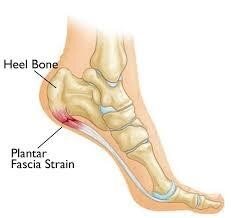What Is Plantar Fasciitis?
Plantar fasciitis is one of the most common causes of foot pain. It is characterized by a sharp pain or burning sensation in the bottom of the foot closer to the calcaneus (heel bone). Inflammation of the connective tissue that runs along the bottom of the foot which connects the heel to the toes is a common cause of this pain.

How is it caused?
One common cause of plantar fasciitis can be falling arches along the medial edge of the foot, which can be a result of the inhibition of the tibialis anterior muscle that connects there.
However, the most common cause for plantar fasciitis is not in the affected foot itself, but in the opposing foot. How can something on one foot have such a substantial effect on the other? The reason it can is that the body functions as a holistic unit with connecting parts. It is very common that plantar fasciitis is a result of an undiagnosed issue in the opposing leg. Not only can an issue at the ankle travel up and manipulate the hip, or vice versa, but it can also cause more strain on the opposing limb. This is because while walking, we will spend more time on one leg than the other, eventually irritating the tissues due to overload, and there you have it- inflammation, tissue strain, and pain.
How do you fix it?
The best method of fixing plantar fasciitis is finding the issue in the other limb that is causing additional stress on the affected foot. There are often primary and secondary pathologies to an injury and if only the secondary pathology is treated, it will allow the injury to return. With plantar fasciitis, there are multiple issues that need to be addressed- the primary pathology being the other leg. This should be addressed first in order to find out what inhibition or over-working tissue is causing the loss of functional integrity in the apparently non-injured limb. Once the primary issue has been identified and corrected, one can then identify the secondary pathology- the inflammation within the painful foot.
The inflammation in the foot can be addressed in multiple ways. The most effective and immediate being manual techniques used by our physiotherapists and massage therapists.
The second method of fixing the affected area is to strengthen the muscles associated with the medial arch, like the tibialis anterior (and others). By eliminating the inhibition in the tibialis anterior and related muscles, you can regain the integrity of the medial arch, allowing effective supination and pronation during the gait cycle, reducing the strain and overload on the affected plantar fascia.
There are many many ways to provide temporary relief of pain and improvement in function. In order to provide long term results, both the primary (often the opposing leg) and secondary issue (local pain, weakness, and tissue overuse) need to be resolved.
Written by Matt O’Brien (Personal Trainer and Bachelor of Kinesiology Student) & Mathew Hughes (Physiotherapist & Owner of Body Science Therapy & Performance Centre).
Edited by Mathew Hughes & Sarah Tringale (Traditional Chinese Medicine Practitioner Candidate).
